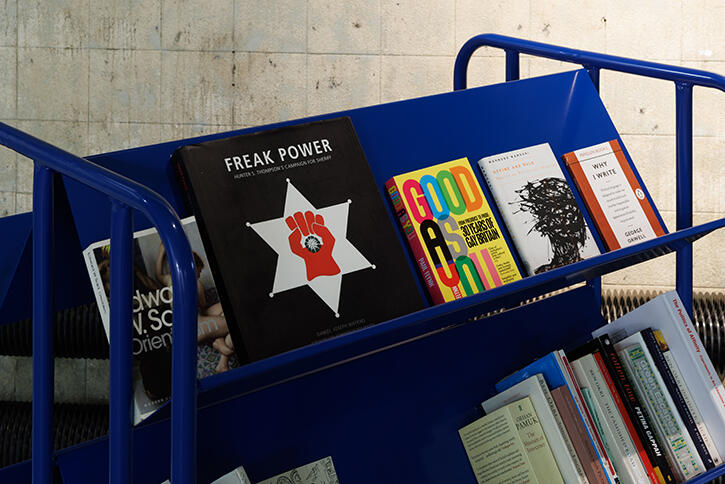‘Testament’ Questions the Moments We Memorialize
A new exhibition at Goldsmiths CCA, London, invites 47 artists to propose solutions to that reliably problematic artform, the monument
A new exhibition at Goldsmiths CCA, London, invites 47 artists to propose solutions to that reliably problematic artform, the monument

An exhibition born of an assignment, ‘Testament’ at Goldsmiths CCA tasks 47 UK and UK-based artists with creating ‘proposal works’ reflecting on that reliably problematic artform, the monument, against a national backdrop shaped by Brexit, COVID-19, the Black Lives Matter movement and looming ecological crises. This curatorial format is not entirely unprecedented: in 2007, the smart and melancholy show ‘Memorial to the Iraq War’, at London’s Institute of Contemporary Arts, solicited proposals for works commemorating George W. Bush and Tony Blair’s disastrous military adventurism in the Middle East. Still, ‘Testament’ is an undoubtedly timely exercise. Recent campaigns for the removal of numerous historic public sculptures and direct actions to this end (notably the sinking of a bronze statue of the slaver Edward Colston into Bristol Harbour by antiracism protestors in 2020) demand a rethinking of the monument, and how it might be proofed, if at all, against hindsight’s searching glare.
Amelioration is at the heart of several artists’ proposals. Rabiya Choudhry’s painting The Lost Ones (2021) depicts a towering, candle-shaped beacon that testifies to the universal experience of loss, while also lighting a dark urban street, making it safer for the vulnerable to walk alone with their thoughts. Abbas Zahedi’s Police Book Exchange (2022) provides shelves of literature (including works by Fyodor Dostoevsky and George Orwell) selected by local residents to expand the intellectual horizons of London’s cops. In his video A proposal for a parakeet’s garden (2021), Adham Faramawy offers a welcoming environment to a population of migrant birds who have made the British capital their home, an example of hospitality to new arrivals that the UK government would do well to emulate.

Ghislaine Leung’s inflatable public house, 385cm/600cm (2021), might be read as a monument to the pub’s place in the British psyche as somewhere different tribes come together in a warm, beery fug. Such communal leisure was, of course, put on pause during the coronavirus lockdowns, when social media replaced social life for many. Nearby, Jeremy Deller’s plaque Culture War Memorial (2022) proposes commemorating those fallen to ‘disinformation and conspiracy theories’ with ‘an apparently bottomless sink hole’. Some might feel that this short text work illuminates our current epistemological crisis; others that it resembles a (perhaps somewhat smugly) humorous Tweet, reverberating in an online echo chamber.
The title ‘Testament’ suggests at once the giving of evidence, the profession of faith and the passing on of a material legacy, and the strongest works in the exhibition touch on all these things. An ecclesiastical-looking shroud stitched from black, gold and violet silk – Elizabeth Price’s Renderer for an unspecified statue (2022) – is intended to be draped over monuments that have fallen from grace, obscuring their surface detail while preserving a ghostly echo of their form. Such a gentle, wholly reversible intervention might satisfy neither conservatives nor iconoclasts, but it poses an important question: are the meaning and power-relations we perceive in a given art object nothing more than temporary adornments, subject to change, or are they inherent and perpetual?

Roger Hiorns exhibits a series of protestors’ placards damning the UK government’s handling of the 1990s variant Creutzfeldt-Jakob Disease crisis, giving raw and vivid context to his written proposal for Pathways (2007–ongoing): a memorial to 177 young people who died from the degenerative brain disease. The artist envisions a modest sheet of sterling silver, installed in a quiet spot near the Houses of Parliament, which the victims’ family and friends are encouraged to anoint with scents that remind them of their loved ones, creating brief bursts of olfactory presence and more permanent stains. The evanescent, yet slowly accretive beauty of this repeated gesture is determinedly non-monumental – that’s to say, exactly what a 21st-century monument should be.
Main image: Roger Hiorns, Pathways, 2007–ongoing, installation view. Courtesy: the artist, Goldsmiths CCA; photograph: Rob Harris























